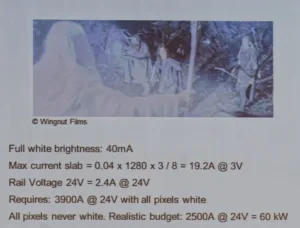The afternoon session was kicked off by Francis Cagney of ND Satcom, who had looked at the issues of trying to drive a FullHD LED display.
He explained how LED walls are made of tiles of individual devices and in FullHD, you need 2 million LEDs (well, arguably, 6 million, but he was talking about tri-colour LEDs – each of which contains three devices). Driving is quite different for LEDs because you can’t adopt a simple row column matrix. In fact, it can get confusing to talk about row and column drivers, he said, and better to talk about low side drivers and high side drivers for each block. In his design there were 16 x 8 LEDs in a block and 10 blocks in a slab, giving 1280 LEDs overall.
Individual LEDs do not have brightness control – so pulse width modulation (PWM) is used to control the brightness. The longer the time that the LED is on, the brighter the pixel. The timing of the power on for different parts of the display is staggered to spread the current load – columns don’t switch instantly, so there are a number of timing challenges.
How much current is needed, Cagney asked? With 40mA LEDs, – a maximum brightness slab is 1280 x 3 / 8 (as there are eight driving columns), that means around 19.2A at the 3V needed to drive the devices, although power is normally provided at a higher voltage (he actually used 24V = so 2.4A is needed).
That would mean that a fullHD display needs 3900A @24V – but a realistic budget is around 2500A @24V = 60kw as image on the display is never pure white and the controllers do have a general brightness level control that can be used to limit the overall brightness.
EMF emissions are difficult to control with 960 columns of data to be refreshed e.g. with 8 columns at 120Hz. Staggering driving spreads the load which limits the overall EMF emissions and also the power peak.
How do you get data into the system? 1920 x 1080 x 24 x 120 which is 5.92Gb/sec. LVDS is ideal for driving up to 440MB/s, so the system design was split into 27 channels (from row slabs), allowing full display driving.
In discussions with Cagney, we found that this was an engineering exercise and a full display had not been built and tested. He seemed surprised that there are a number of companies around that are offering FullHD and even UltraHD LED systems.

